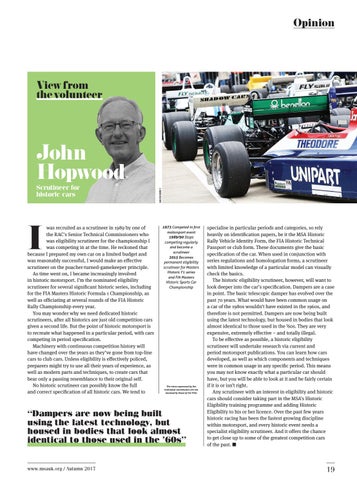Opinion
View from the volunteer
Scrutineer for historic cars
I
was recruited as a scrutineer in 1989 by one of the RAC’s Senior Technical Commissioners who was eligibility scrutineer for the championship I was competing in at the time. He reckoned that because I prepared my own car on a limited budget and was reasonably successful, I would make an effective scrutineer on the poacher-turned-gamekeeper principle. As time went on, I became increasingly involved in historic motorsport. I’m the nominated eligibility scrutineer for several significant historic series, including for the FIA Masters Historic Formula 1 Championship, as well as officiating at several rounds of the FIA Historic Rally Championship every year. You may wonder why we need dedicated historic scrutineers, after all historics are just old competition cars given a second life. But the point of historic motorsport is to recreate what happened in a particular period, with cars competing in period specification. Machinery with continuous competition history will have changed over the years as they’ve gone from top-line cars to club cars. Unless eligibility is effectively policed, preparers might try to use all their years of experience, as well as modern parts and techniques, to create cars that bear only a passing resemblance to their original self. No historic scrutineer can possibly know the full and correct specification of all historic cars. We tend to
JAKOB EBREY
John Hopwood 1973 Competed in first motorsport event 1989/90 Stops competing regularly and become a scrutineer 2015 Becomes permanent eligibility scrutineer for Masters Historic F1 series and FIA Masters Historic Sports Car Championship
The views expressed by the individual contributors are not necessarily those of the MSA.
“Dampers are now being built using the latest technology, but housed in bodies that look almost identical to those used in the ’60s” www.msauk.org / Autumn 2017
19_MSA Volunteer GW GW.indd 1
specialise in particular periods and categories, so rely heavily on identification papers, be it the MSA Historic Rally Vehicle Identity Form, the FIA Historic Technical Passport or club form. These documents give the basic specification of the car. When used in conjunction with series regulations and homologation forms, a scrutineer with limited knowledge of a particular model can visually check the basics. The historic eligibility scrutineer, however, will want to look deeper into the car’s specification. Dampers are a case in point. The basic telescopic damper has evolved over the past 70 years. What would have been common usage on a car of the 1980s wouldn’t have existed in the 1960s, and therefore is not permitted. Dampers are now being built using the latest technology, but housed in bodies that look almost identical to those used in the ’60s. They are very expensive, extremely effective – and totally illegal. To be effective as possible, a historic eligibility scrutineer will undertake research via current and period motorsport publications. You can learn how cars developed, as well as which components and techniques were in common usage in any specific period. This means you may not know exactly what a particular car should have, but you will be able to look at it and be fairly certain if it is or isn’t right. Any scrutineer with an interest in eligibility and historic cars should consider taking part in the MSA’s Historic Eligibility training programme and adding Historic Eligibility to his or her licence. Over the past few years historic racing has been the fastest growing discipline within motorsport, and every historic event needs a specialist eligibility scrutineer. And it offers the chance to get close up to some of the greatest competition cars of the past. n
19 01/09/2017 13:35
